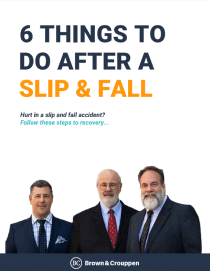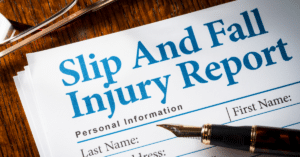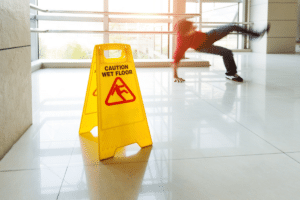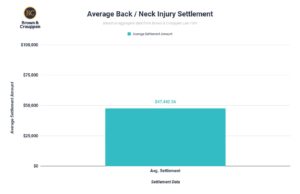
Use our checklist to learn what to do after a fall and understand key legal considerations.
About the Factors Used to Calculate Slip & Fall Settlements
The factors below generally have the largest impact on settlement value, and you may choose to use an online slip and fall settlement calculator to estimate the potential value of your claim. However, it’s important to note that each case is unique, and the final settlement amount will vary based on many factors. To get the most accurate estimate regarding the value of your claim, consult a slip and fall attorney by requesting a free case evaluation online.
1. Liability or Fault
Slip and fall accidents fall under the umbrella of premises liability negligence claims. To establish a claim for premises liability in Missouri, a plaintiff must show the following:
- A dangerous condition existed on the defendant’s premises which involved an unreasonable risk;
- The defendant knew or by using ordinary care should have known of the condition;
- The defendant failed to use ordinary care to remove or warn of the danger; and
- The plaintiff sustained injuries as a result of such a condition.
The concept of fault in a premises is essentially the same across the United States. Whose actions (or inactions) caused the fall? However, state laws vary on how to calculate damages based on fault. The main difference between them is that some states have adopted contributory negligence versus comparative fault rules.
States that follow “pure” comparative negligence laws abide by the rule that the plaintiff’s percentage of fault reduces their compensation reward, regardless of what their percentage of fault is. Under pure comparative negligence models, the injured party may receive compensation for their injuries even if they were more than 50% at fault for the wreck, though their recovery will be reduced by their shared percentage of fault. Missouri is a pure comparative fault state.
Modified comparative negligence laws place a cap on how much fault the plaintiff can hold. Many states generally cap this limit at equal to or more than 50%. If the plaintiff proves to be more than 50% at fault, they may not collect damages. Kansas and Illinois are modified comparative fault states.
2. The Severity of the Injuries
As the injured party filing a slip and fall claim, you have the burden of proof not only that the other party is at fault for your injuries but also that you suffered the actual injuries, that the incident caused the injuries, and that you experienced limitations and soreness after the fall. The insurance company will not take you at your word. They want to pay as little as possible on your claim. You can prove your injuries and limitations by providing medical bills and records as well as information from your employer about lost wages (or tax returns if you are self-employed).
Not surprisingly, the severity of the injuries impacts the overall settlement amount. Higher medical bills necessitate more money for economic damages (i.e., actual bills incurred rather than non-economic damages such as pain and suffering). Even if you have health insurance, and your insurer pays those bills, the health insurance carrier often has a right to repayment for those amounts that need to be considered in negotiating a settlement.
Note: In a slip and fall case, compensation for pain and suffering can range from $2,000 to $100,000 or more.
Occasionally medical bills are low, but the injured party will suffer the consequences of their injury for the remainder of their life. This is especially true with a head injury or a fracture (healed fractures still lead to an increased risk of arthritis in the affected location).
3. Lost wages
The value of a slip and fall settlement can be significantly impacted by lost wages. When an individual sustains injuries as a result of a slip and fall accident, they may be forced to take time off work for medical treatments, recovery, and rehabilitation.
The lost wages during this period may be factored into the economic damage impact on the victim. In a settlement negotiation, the calculation of lost wages typically involves assessing the individual’s salary or hourly rate, factoring in the duration of time they were unable to work, and considering any future earning capacity affected by the injuries. The inclusion of lost wages in settlement calculations not only compensates for the immediate financial strain on the injured party, but it also accounts for the potential long-term consequences.
4. Insurance Coverage
Most individual homeowners and even small businesses carry some level of liability insurance for financial protection in case an accident or injury occurs on their premises. For homeowners and businesses that rent space, if there’s a mortgage on the property, there’s likely to be insurance coverage on the property. For businesses, if they are large-box companies, they will likely have their own risk management or claims department and are self-insured.
If for some reason there isn’t any insurance available, you may still file and receive a default judgment (assuming the defendant doesn’t hire personal counsel and defend the suit) and an award for damages. However, it will be difficult to collect those damages without a solvent defendant or insurance coverage.
Estimating the Value of a Slip & Fall Settlement
There is no generic formula for calculating an appropriate settlement value in the personal injury sphere. Although there are calculators and formulas in the Worker’s Compensation legal sphere for calculating the appropriate settlement value, that does not exist in the personal injury sphere.
An appropriate slip and fall settlement is based on many factors (including and especially the factors listed above) and on the injured party’s risk tolerance (i.e., whether they are willing to settle pre-trial or whether they want to risk taking the case before a jury and letting the jury decide their fate).
- $0 – $100,000 cases: You can expect that if you have a soft tissue injury (i.e., no fractures, no head trauma, no surgical recommendations, and no positive findings on MRI or CT scans for neurologic/ligament injuries), your settlement will likely be under $100,000. Minor fractures or tears without surgical intervention may also fall into this category (such as a toe or pinky finger fracture, most rib fractures, etc).
- $100,000 – $250,000 cases: More serious injuries fall into this range. This may be a broken leg that healed without surgical intervention but required the injured party to “hobble” around on crutches and/or use a scooter for months. This may be a mild TBI with treatment that largely healed over time.
- $250,000 – $1,000,000+ cases: These are going to be your more serious cases. Perhaps there’s a partial amputation of a finger. Perhaps there’s a disc herniation where no surgery occurred but it’s been recommended. This could be for even more serious injuries where the injured party was partially at fault for their injuries as well.
Get Help With Your Slip And Fall Case From Brown & Crouppen Law Firm
If you or a loved one has suffered injuries from a slip and fall on another’s property, you may be eligible to receive financial compensation for lost wages, medical expenses, pain and suffering, and other damages.
Getting started is easy. Get help from our slip and fall attorneys by calling us at 888-795-0694 for a free consultation, or get in touch with our legal team by requesting a free case evaluation online. And remember, there’s no upfront cost to you — if you don’t get paid, we don’t get paid.








